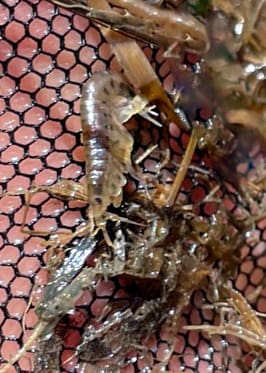By Sue Crowley, executive director

I must admit I do not know much about fish or other cool aquatic organisms living their best life in our local waterways. In the summertime, playing or exploring along or in a stream always seemed like a great activity when I was growing up. I did not care what things were called. It was enough to just explore without an obligation to name and classify.
At the Dunes, we are working on a large stream restoration project where the goal is to rehab a waterway that was straightened to simplify its footprint and maximize our ability to use the rest of the area around the creek for agriculture. The “historical we” essentially transformed the area into a ditch that was narrow, and as time passed, the waters carved it more deeply. This ditch formation did not allow for much diversity of habitat along its course. It did not favor occasional overflows that create temporary wet spots or micro sites where wetland species plants and animals could thrive. Ok, the ditch version did sometimes overflow, but not in the manner a more natural winding waterway might do.
The re-meander of the stream which our project is creating, also provides for a more varied structure within the stream. Things like a deep spot or bend just below a drop in the topography. It has some areas of rocky bottoms, while other stretches have a sandy component and then mix in some wood materials that provide both support for the stream bank and good places for aquatic creatures to take some refuge from the main flow. I suppose you could think of it as a rest stop along the interstate.
Back in March this year, we needed to prevent fish and other larger aquatic species from breeding/spawning in the project area because we would soon need to redirect the water into the newly meandered channel and then fill in the old ditched one.
With the task of catching fish and other species, I began to learn a bit more about the fish in this waterway as well as some other interesting critters. One such critter turned out to be called a scud. This small creature that could fit on my thumbnail caught my eye. See the photo! A scud looks like a tiny shrimp, and it moves on its side. They move along with their clawed legs and body contortions. Scuds are not insects but Arthropods. They fall under Crustacea (think shrimplike) and they fit into the order Amphipoda. Scuds like to live in tangled vegetation and at the bottoms of waterways. The environment is best when there is some calcium in the water to help with their shells.
Scuds live for about one year. They experience the world through their antennae. Scuds do not prefer light, and their antennae are sensitive to touch and smell! They contribute to the ecosystem as detritivores, meaning that the eat detritus, meaning they consume decaying organic materials from plants and other organisms. They also feast on algae, fungi, and bacteria that may cover underwater leaves. Consequently, they may help to keep the water clean.
Scuds themselves may be eaten by aquatic insects, salamanders, some birds, and of course, some fish. Apparently scuds have freshwater and marine water versions. You need a microscope to distinguish different genus’ from each other.
Fast forward to the end of May, when our project was about to do the actual redirection of the water to the new channel. We did two intensive passes of the ditched creek to remove and relocate as many fish as possible and other critters much farther downstream. When I pulled my net up to check for critters, I was stunned to find my 12-inch X 12-inch net covered with scuds! I’ll be honest, I was glad I was wearing my chest waders and not just my knee boots. All I could think of was having all the scuds flood into my boots should I inadvertently step in a deep spot! I am happy we were able to save a bunch of critters that day, including some scuds!
Nature and all the different critters in the varied environments provide endless opportunities for learning and understanding more about the planet we share. The next time you are near or in a creek, take a close look to see if you are lucky enough to see a scud!
photo of scud by Sue Crowley
